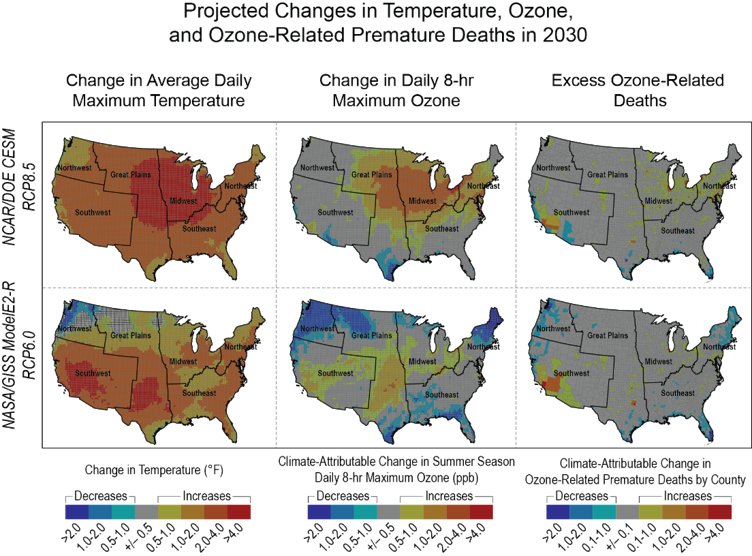Projecting Changes to Human Health with CMAQ
As of 2015, over 120 million Americans live in counties where air pollution levels exceed the National Ambient Air Quality Standards. Ground-level ozone and fine particle pollution (PM2.5) are the overwhelming contributors to these cases of poor air quality, and both of these pollutants have significant adverse effects on human health through respiratory and/or cardiovascular impacts. Actions to reduce the emissions that lead to high levels of ozone or fine particles have been extremely successful over the past 20 years; since 2000, ozone levels have been reduced by 17% and fine particle concentrations have been reduced by 37% (USEPA, 2016).
However, climate change has the potential to slow the improvements to U.S. air quality by altering weather patterns and increasing the prevalence of conditions that lead to episodes of poor air quality (Jacob and Winner, 2009; Fiore et al., 2015). CMAQ analyses of the effects of climate change on air quality have informed the U.S. Global Change Research Program Climate and Health Assessment (Fann et al., 2016; USGCRP, 2016) as well as the Fourth National Climate Assessment (Nolte et al., 2018a; USGCRP, 2018).
Future projections from global climate models were dynamically downscaled using the Weather Research and Forecasting (WRF) model to generate the evolution of weather conditions over North America under different scenarios. These WRF fields were then used with CMAQ to create the corresponding air quality projections that are influenced by the future weather conditions. The outcomes from the WRF and CMAQ projections were used to quantify potential health effects resulting from changes to weather, climate, and air quality. The future health impacts of climate change resulting from degraded air quality could be significant, leading to economic costs perhaps into the billions of dollars (Fann et al., 2015). Initial results (Nolte et al., 2018b) focused on effects on human health through 2030, but on-going studies are examining projected changes at 2050 and 2095.
References
Dionisio, K.L., Nolte, C.G., Spero, T.L., Graham, S., Caraway, N., Foley, K.M., Isaacs, K.K. (2017). Characterizing the impacts of projected changes in climate and air quality on human exposures to ozone. J. Expos. Sci. Environ. Epidemiol., doi:10.1038/jes.2016.81Exit.
Fann, N., Brennan, T., Dolwick, P., Gamble, J.L., Ilacqua, V., Kolb, L., Nolte, C.G., Spero, T.L., Ziska, L. (2016). Ch. 3: Air Quality ImpactsExit. In The Impacts of Climate Change on Human Health in the United States: A Scientific Assessment. U.S. Global Change Research Program, Washington, DC, 69–98.
Fann, N., Nolte, C.G., Dolwick, P., Spero, T.L., Curry Brown, A., Phillips, S., Anenberg, A. (2015). The geographic distribution and economic value of climate change-related ozone health impacts in the United States in 2030. J. Air Waste Manage. Assoc., 65, 570–580, doi:10.1080/10962247.2014.996270Exit.
Fiore, A.M., Naik, V., Leibensperger, E.M. (2015). Air quality and climate connections. J. Air Waste Manage. Assoc., 65, 645-685, doi:10.1080/10962247.2015.1040526Exit.
Jacob, D.J., Winner, D.A. (2009). Effect of climate change on air quality. Atmos. Environ., 43, 51-63, doi:10.1016/j.atmosenv.2008.09.051Exit.
Nolte, C.G., Dolwick, P.D., Fann, N., Horowitz, L.W., Naik, V., Pinder, R.W., Spero, T.L., Winner, D.A., Ziska, L.H. (2018a). Air QualityEXIT. In Impacts, Risks, and Adaptation in the United States: Fourth National Climate Assessment, Volume II, U.S. Global Change Research Program, Washington, DC.
Nolte, C.G., Spero, T.L., Bowden, J.H., Mallard, M.S., Dolwick, P. (2018b). The potential effects of climate change on air quality across the conterminous U.S. at 2030 under three Representative Concentration Pathways. Atmos. Chem. Phys., 18, 15471-15489, doi:10.5194/acp-18-15471-2018Exit.
USEPA, 2016: National Air Quality – Status and Trends of Key Air Pollutants.
USGCRP, 2016: The Impacts of Climate Change on Human Health in the United States: A Scientific AssessmentExit. Crimmins, A., J. Balbus, J.L. Gamble, C.B. Beard, J.E. Bell, D. Dodgen, R.J. Eisen, N. Fann, M.D. Hawkins, S.C. Herring, L. Jantarasami, D.M. Mills, S. Saha, M.C. Sarofim, J. Trtanj, and L. Ziska (eds.). U.S. Global Change Research Program, Washington, DC, 312 pp.
USGCRP, 2018: Impacts, Risks, and Adaptation in the United States: Fourth National Climate Assessment, Volume IIExit. Reidmiller, D.R., C.W. Avery, D.R. Easterling, K.E. Kunkel, K.L.M. Lewis, T.K. Maycock, and B.C. Stewart (eds.). U.S. Global Change Research Program, Washington, DC, 1515 pp.
Wilson, A., Reich, B.J., Nolte, C.G., Spero, T.L., Hubbell, B., Rappold, A.G. (2016). Climate change impacts on projections of excess mortality at 2030 using spatially-varying ozone-temperature risk surfaces. J. Expos. Sci. Environ. Epidemiol., doi:10.1038/jes.2016.14Exit.

